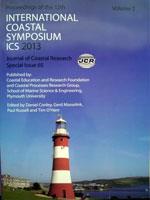Eom, J., Choi, J.K.., Lee, Y.K., Ryu, J.H., Won, J.S., 2013. Standardization of sedimentary facies and topography based on the tidal channel type in Western coastal area, Korea
The tidal flat area along the west coast of the Korean Peninsula is among the largest in the world. The Ganghwa-do tidal flat, which is an open type, the Geunso-bay tidal flat, which is a semi-closed bay, and the Hwang-do tidal flat in Cheonsu Bay have different benthic environments, formed by different surface sedimentary facies and topographic features. These benthic environments in each tidal flat are influenced mainly by the tidal channel network. In other words, knowledge of the tidal channel distribution pattern is a key for understanding the geophysical and surface-sedimentary facies. From a quantitative estimate of the tidal channel distribution pattern, it is possible to estimate the surface sedimentary facies and topographical features. In this study, we standardized the surface sedimentary facies and topography by developing a tidal flat index in terms of the tidal channel distribution pattern. To extract tidal channel data in the study area, we used remotely sensed data, such as those from the Korea Multi-Purpose Satellite-2 (KOMPSAT-2), Landsat Enhanced Thematic Mapper Plus (ETM ), and aerial photographs. In addition, we generated a digital elevation model (DEM) using the waterline method to standardize the topographic features. Surface sedimentary facies maps were generated based on field data using an interpolation method. From these data, we calculated the tidal channel index by a fractal method. We also analyzed the spatial correlation of the tidal channel index with surface sedimentary facies and topography, respectively, using a GIS tool. Low values of the tidal channel index, which indicated a simple pattern of tidal channel distribution, were identified at areas having low elevation and coarse-grained sediments. By contrast, high values of the tidal channel index, which indicated a dendritic pattern of tidal channel distribution, were identified at areas having high elevation and fine-grained sediments.





